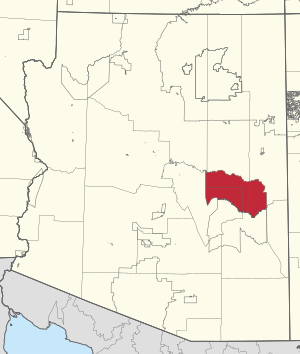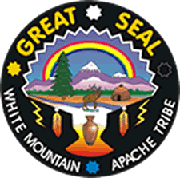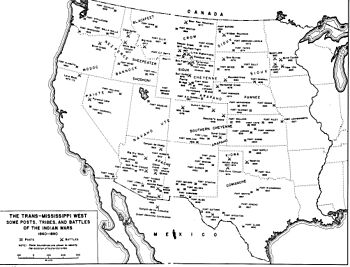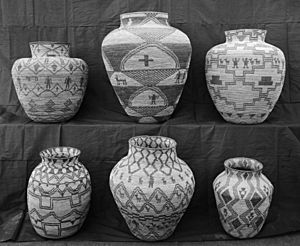Fort Apache Indian Reservation facts for kids
| Dził Łigai Si'án N'dee (Western Apache) | |
|---|---|
|
Seal of the White Mountain Apache tribe
|
|

Location of the Fort Apache Indian Reservation
|
|
| Total population | |
| 12,429 | |
| Regions with significant populations | |
| Languages | |
| Western Apache, English | |
| Religion | |
| Christianity (especially Catholicism & Lutheranism), White Mountain Apache Culture | |
| Related ethnic groups | |
| Western Apache, San Carlos Apache, Navajo |
The Fort Apache Indian Reservation is a special area of land in Arizona, United States. It covers parts of Navajo, Gila, and Apache counties. This reservation is the home of the White Mountain Apache Tribe of the Fort Apache Reservation. This tribe is officially recognized by the U.S. government. In their own language, they are called Dził Łigai Si'án N'dee.
The reservation is huge, covering about 1.6 million acres. As of the year 2000, over 12,000 people lived there. The biggest town on the reservation is Whiteriver.
Contents
A Look at White Mountain Apache History
The word "Apache" was a name given by European settlers to the White Mountain Apache and other Apache groups. The White Mountain Apache people were made up of three main groups. These groups had smaller family units called bands and clans. There were special rules about who could marry whom, based on their clan.
The three main groups had traditional names in the White Mountain Apache language. One group was known as "On Top of Mountains People." Another was called "Many Go to War People." The third group was known as "At the Base of the Mountains People." Some White Mountain Apache people today want these original names to be used more often.
Fort Apache and the U.S. Army
In 1870, the U.S. Army set up a fort called Fort Apache. It was first named Camp Apache. White Mountain Apache leaders actually suggested building this fort. They knew that the Navajo were resisting U.S. control. Before this, the U.S. had forced the Navajo and Mescalero Apache on a difficult journey called the Long Walk of the Navajo. They were held far from their homes for years before being allowed to return in 1868.
In 1871, General George Crook asked 50 White Mountain Apache men to be scouts for his army. This was during the Apache Wars, which lasted for about 15 years. These wars ended when the Chiricahua leader Geronimo surrendered in 1886. Because the White Mountain Apache scouts helped General Crook, he worked to make sure the tribe could keep a large part of their homeland as their reservation.
From Military Post to School
The U.S. Army left Fort Apache in 1922. The next year, in 1923, the fort was given to the Bureau of Indian Affairs (BIA). The BIA then opened an Indian Boarding School there. It was named after President Theodore Roosevelt.
In 2012, the school was recognized as a National Historic Landmark. This means it's a very important historical site. Today, the White Mountain Apache tribe runs the Roosevelt Indian School as a middle school. They work with the Bureau of Indian Education, which helps fund the school.
Geography of the Reservation
The Fort Apache Indian Reservation is mostly covered by thick pine forests. Many different kinds of forest animals live here. It is located just south of the Mogollon Rim, a large cliff edge. The highest point on the reservation is Baldy Peak, which is about 11,403 feet (3,476 meters) tall.
Economy and Attractions

The White Mountain Apache Tribe runs several businesses. They operate the Sunrise Park Resort, which is a ski resort. They also have the Hon-Dah Resort Casino and Conference Center. The tribe has built the Apache Cultural Center & Museum. This museum is built in the traditional style of a gowa, which is a traditional Apache home.
Other interesting places on the reservation include the Fort Apache Historic Park. This park has 27 original buildings from the historic fort. It is also a National Historic Landmark District.
The Kinishba Ruins are another important site. These are ancient ruins from the Pueblo culture, dating back to 1150–1350 CE. They are also a National Historic Landmark. You can visit these ruins by making an appointment.
Communities on the Reservation
The Fort Apache Indian Reservation has several small communities. In 2010, the total population of these communities was 22,036 people.
Getting Around
The White Mountain Apache Tribe runs a local bus service called Fort Apache Connection Transit. The nearby City of Show Low also has a bus service called the Four Seasons Connection. This bus goes from the Hondah Casino to Show Low and Pinetop-Lakeside.
Education
Some parts of the reservation used to be part of the Young Elementary School District. In 1984, the Young district arranged for the Whiteriver Unified School District to teach about 200 students from Fort Apache. This was because the roads between Fort Apache and Young were hard to use. As of 2020, these parts of the reservation are now directly in the Whiteriver Unified School District.




